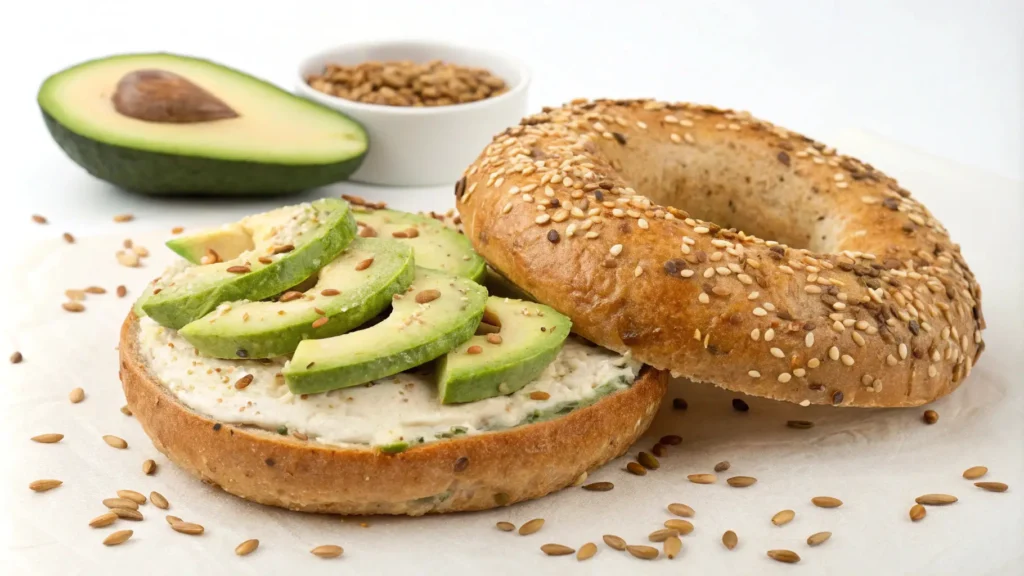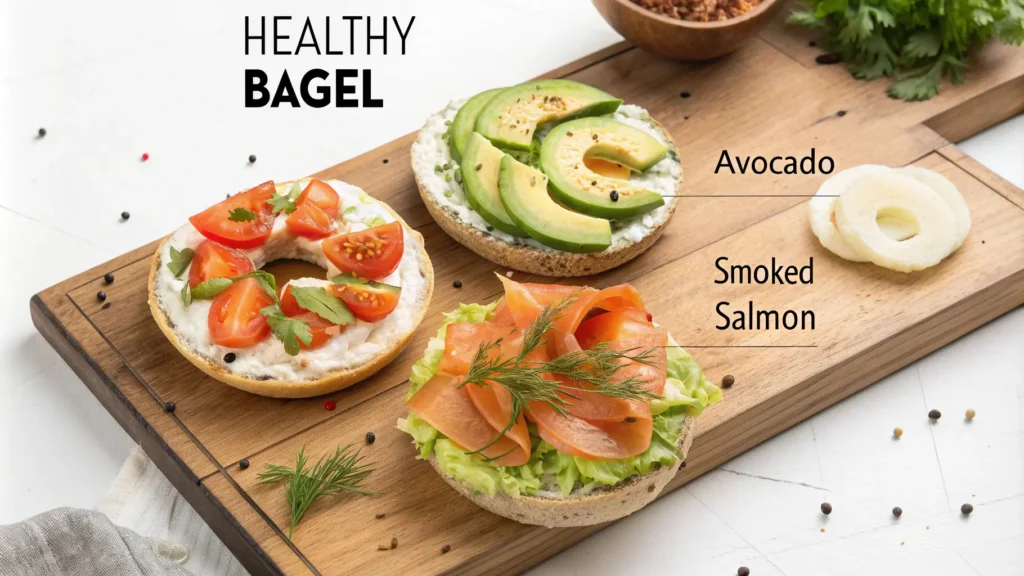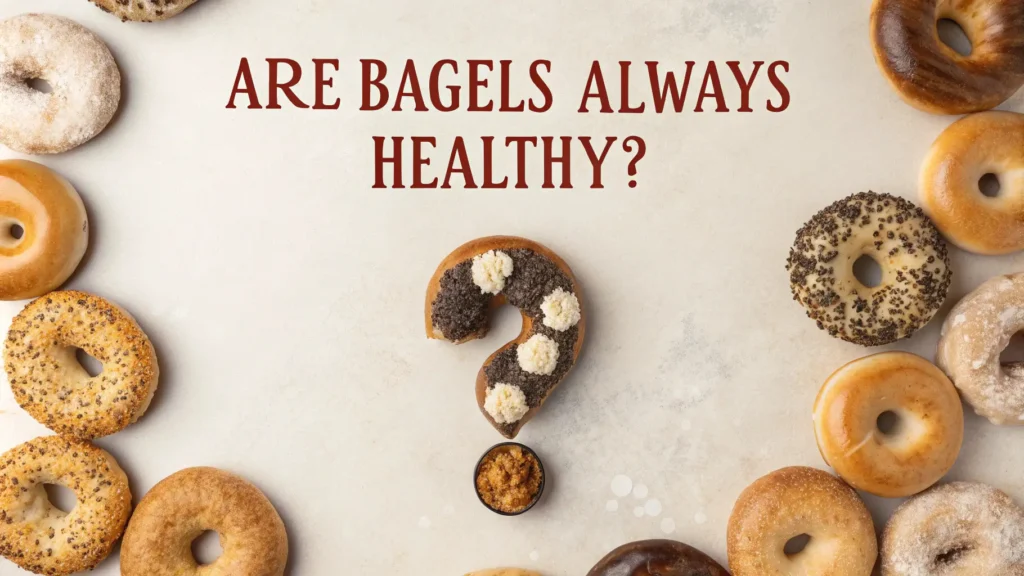Bagels are a beloved breakfast staple, but they often come with a bad rap for being calorie-dense and loaded with refined carbs. Yet, they don’t have to be a guilty pleasure! By making smarter choices and exploring healthier bagel options, you can enjoy this satisfying treat without compromising your well-being. In this article, we’ll dive into what makes a bagel healthy, explore various nutritious choices, and share tips on picking and topping your bagel for maximum health benefits. Let’s uncover the answer to the burning question: What’s the healthiest bagel to eat?

Introduction to Bagels and Health
What Are Bagels?
Bagels are dense, chewy rings of bread traditionally boiled before being baked. Originating from Eastern Europe, they’ve grown into a worldwide phenomenon, loved for their satisfying texture and versatility. Whether you like yours toasted with butter or piled high with toppings, bagels can fit almost any craving.
Overview of Their Popularity and Variations
From classic plain bagels to trendy multigrain and protein-packed varieties, bagels have evolved into a breakfast powerhouse. Popular options now include sprouted grain bagels, low-carb bagels, and even gluten-free alternatives, catering to diverse dietary needs. Each variety offers something unique, but the question remains: are they all equally healthy?
Why Consider the Health Aspect of Bagels?
Not all bagels are created equal. Traditional options made with refined white flour are often high in calories but lack essential nutrients like fiber and protein. However, healthier bagels—like those made from whole grains or sprouted grains—can provide a balanced mix of carbs, fiber, and protein while being lower on the glycemic index. For those looking to enjoy bagels without sacrificing nutrition, choosing the right kind is key.
By understanding the nutritional landscape of bagels and learning how to make informed decisions, you can enjoy this breakfast classic in a way that aligns with your health goals. Stay tuned as we explore the healthiest bagel options in the following sections!
Nutritional Profile of Bagels
Standard Nutritional Components in a Bagel
Bagels may look simple, but they pack a lot into every bite. A typical plain bagel, made from refined white flour, contains around 250-300 calories, 50-55 grams of carbohydrates, and minimal fiber. However, bagels can vary widely in nutrition based on their size, ingredients, and toppings. This makes it essential to know what you’re eating, especially if you’re asking yourself, “What’s the healthiest bagel to eat?”
Common Ingredients: Refined Flour vs. Whole Grain
One of the most significant differences in bagels lies in their flour. Bagels made with refined flour are stripped of most fiber, vitamins, and minerals during processing. This means they’re digested quickly, often leading to blood sugar spikes and crashes. On the other hand, bagels made from whole grains or sprouted grains retain their fiber and nutrients, helping you stay full longer and providing steady energy.
Caloric Content of Typical Bagel Types
Bagels range from smaller 150-calorie options like “bagel thins” to massive, 400-calorie New York-style bagels. If you’re trying to manage your weight or eat healthier, size and portion control are critical. Adding toppings can also dramatically change the nutritional profile—cream cheese and butter can double the calorie count, while lean protein or hummus can add a nutritious boost.
Understanding these variations is the first step toward making smarter choices and finding the healthiest bagel to suit your diet.
The Healthiest Bagel Options

Whole Wheat Bagels
When it comes to healthy bagels, whole wheat varieties often top the list. Packed with fiber, vitamins, and minerals, these bagels are a heart-healthy choice. Their high fiber content aids digestion and keeps you feeling satisfied longer. Plus, they’re less likely to cause blood sugar spikes compared to refined options. If you’re still pondering, “What’s the healthiest bagel to eat?”—whole wheat is a great contender.
Sprouted Grain Bagels
Sprouted grain bagels are another fantastic option for health-conscious eaters. Made from sprouted whole grains, they contain more bioavailable nutrients, which means your body absorbs them more efficiently. They’re also higher in protein and easier to digest, making them perfect for those with sensitive stomachs. Their low glycemic index helps keep blood sugar levels steady throughout the day.
Multigrain Bagels
Looking for variety? Multigrain bagels combine the benefits of several grains, offering a broader spectrum of vitamins, minerals, and fiber. Just ensure that the grains are whole rather than refined. These bagels provide a nutty flavor and a lower glycemic index, making them a delicious and nutrient-dense choice.
Pumpernickel Bagels
For something unique, pumpernickel bagels stand out. Made from coarsely ground rye flour, they’re naturally darker, denser, and lower in carbs. They’re also packed with antioxidants and have a slightly tangy flavor. If you’re seeking a bagel with a distinct taste and health perks, pumpernickel might be your answer.
Choosing the right bagel type doesn’t mean compromising on taste or satisfaction. Whether you prefer whole wheat, sprouted grain, or multigrain options, there’s a healthy bagel out there to match your lifestyle and cravings!
How to Choose a Healthy Bagel
Check the Label: Key Ingredients to Look For
When you’re scanning the bread aisle or bakery shelves, always read the labels. Look for whole grain flour as the first ingredient—it’s a sign of a fiber-rich, nutrient-packed bagel. Avoid those made primarily with refined flour or loaded with added sugars. Bagels with seeds like flax, chia, or sesame can provide extra protein, omega-3s, and healthy fats.
If you’ve ever wondered, “What’s the healthiest bagel to eat?”, remember that it all starts with the ingredients. Organic options are often free from synthetic preservatives, and some even have lower sodium content.
Size and Portion Control: Smaller Bagels or Bagel Thins
Bagel sizes vary a lot, and bigger isn’t always better. Opting for a smaller bagel or bagel thin can save you hundreds of calories while still satisfying your craving. Many low-carb bagels and bagel thins are perfect for controlling portions without giving up the joy of eating a bagel.
Low-Sodium and Low-Sugar Varieties
For those watching sodium or sugar intake, some bagels are specifically marketed as low-sodium or sugar-free. These options are great for maintaining blood pressure and energy levels. Sprouted grain and whole wheat varieties are often naturally lower in sugar and high in fiber, making them a smart choice.
For more bagel ideas and recipes, check out our article on What Is a Black Russian Bagel?.
Enhancing the Nutritional Value of Your Bagel
Toppings to Avoid: High-Fat and Sugary Spreads
Your bagel’s toppings can make or break its health benefits. Avoid heavy cream cheese, butter, and sugary jams, which can add unnecessary calories and fat. Processed cheese spreads and flavored cream cheeses also tend to be high in sodium and additives.
Healthier Spreads and Protein Add-Ons
Swap out unhealthy spreads for options like avocado, hummus, or low-fat Greek yogurt. These alternatives add creaminess without piling on unhealthy fats. For a protein boost, try lean turkey slices, smoked salmon, or a dollop of cottage cheese. They not only taste great but also keep you fuller for longer.
Pairing Bagels with Nutrient-Dense Foods
Pairing a bagel with nutrient-rich sides can elevate its nutritional value. Add fresh veggies like spinach, tomatoes, or cucumbers for extra vitamins and minerals. A bagel with peanut butter and banana slices makes for a fiber-packed, protein-rich breakfast. If you’re asking, “What’s the healthiest bagel to eat?”, the right combination of toppings and sides can make all the difference.
Bagels can be a part of a balanced diet with these tips—just make mindful choices about what goes on top!
Are Bagels Always Healthy?

Potential Drawbacks: Refined Carbs and High Calories
While bagels can be delicious and versatile, they’re not always the healthiest choice. Many traditional bagels are made with refined flour, which lacks essential nutrients and can lead to blood sugar spikes. Large bagels, especially those packed with sugary fillings or toppings, can easily exceed 400 calories. For those trying to manage their weight or blood sugar, this can be a real concern.
Even whole wheat or multigrain bagels, though healthier, aren’t without their pitfalls if eaten in oversized portions or topped with calorie-heavy spreads. If you’ve ever asked yourself, “What’s the healthiest bagel to eat?”, keep in mind that balance is key.
Comparison with Alternative Breakfast Options
Compared to options like oatmeal or Greek yogurt, bagels often fall short in terms of protein and healthy fats. However, when paired with nutritious toppings like avocado or eggs, they can hold their own as a wholesome breakfast. Choosing smaller, whole-grain options helps minimize the drawbacks while maximizing the benefits.
When and How Bagels Fit Into a Healthy Diet
Bagels aren’t a daily necessity, but they can fit into a healthy lifestyle when eaten thoughtfully. Focus on portion control, nutrient-dense toppings, and pairing them with a side of fresh fruit or vegetables. By doing this, you can enjoy a bagel while keeping your health goals on track.
FAQs About Healthy Bagels
What’s the Healthiest Bagel at the Store?
The healthiest store-bought bagels are often labeled as whole grain or sprouted grain. Options like Dave’s Killer Bread bagels or bagel thins are great choices since they offer fiber, protein, and fewer calories. Keep an eye on the ingredient list to avoid refined flours and added sugars.
Can I Eat Bagels Daily and Still Be Healthy?
Eating bagels daily is possible, but moderation is vital. Choose smaller, nutrient-rich bagels and pair them with healthy toppings like Greek yogurt or nut butter. Alternating your breakfast with high-protein options like eggs or oatmeal can help maintain a balanced diet.
Are Gluten-Free Bagels Healthier?
Not necessarily. Gluten-free bagels are a must for those with celiac disease or gluten intolerance, but they’re often made with refined flours like rice or tapioca flour. These lack fiber and may cause blood sugar spikes. Instead, look for gluten-free bagels made with whole grains or added protein.
What Spreads Are Best for Health-Conscious Eaters?
Opt for toppings like avocado, hummus, or low-fat cream cheese. These add flavor and nutrients without the high fat and sugar content of traditional spreads. For a sweet twist, try almond butter with fresh fruit slices.
Bagels can be a satisfying and healthy breakfast choice when approached with care. Wondering, “What’s the healthiest bagel to eat?” comes down to making smart choices that fit your unique health goals.

